Ever deleted all your browser cookies and then regretted it? Sometimes, you need to take those steps, but often you can take a simpler move, such as clearing one site’s cookies. This Google Chrome tutorial shows how to view cookies in Chrome and delete them if needed using multiple methods including Google Chrome DevTools.
I’m going to start broad and then narrow into specifics. Feel free to use the Table of Contents to find your issue. If you’re not familiar with stored cookies, you might wish to read this cookie primer. While it’s not specific to Chrome cookies, the basics apply. Also, the instructions here have been updated to reflect Chrome version 116 and above.
Where possible, I’ll be using browser shortcuts to jump to specific browser settings. This saves you from navigating through drop-down menus, content settings, advanced settings, etc. Just copy and paste the string provided. They will show with a gray background.
Where to Find Your Cookie Settings
To begin, let’s get acquainted with Chrome’s main Cookies area. This is where you can control how the browser handles cookies.
- Open Google Chrome.
- In Chrome’s address bar (some people call it an Omnibox), type or copy the following command.
chrome://settings/cookies- Scroll down till you see Default behavior. Your screen may look different based on your Chrome preferences and updates.
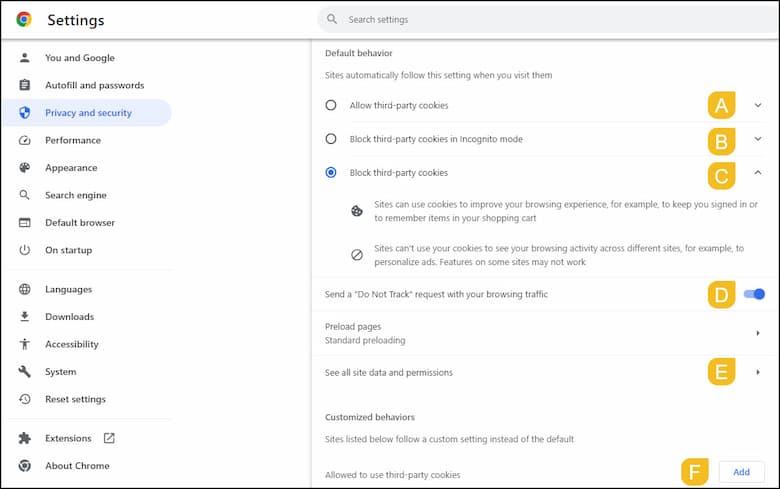
The radio buttons at the top are the primary option. This means as you click one option, another will be turned off. You can only have 1 active selection. If you click the downward chevron ▼ to the right, more details are offered for that option.
[A] Allow third-party cookies
This global toggle determines if the Chrome browser should accept third-party cookies. Previously, this toggle was called “Allow all cookies” which included First-Party cookies or Third-Party cookies. If you toggle this on, you’ll notice the radio button for [C] changes.
The main points are:
- Cookies can provide functionality such as keeping you signed in to online shopping and maintaining what’s in your shopping cart.
- By default, Google Chrome will accept all first-party cookies.
- Some sites may use Third-Party cookies to see your browsing activity across different sites. These are often cookies for advertising for ad personalization. Google has been working to eliminate these types with its Privacy Sandbox initiative. The current target date is sometime in 2024 which also means these panels will change yet again.
[B] Block third-party cookies in incognito mode
This option applies when you use Incognito mode. This mode prevents Chrome from locally storing information. Sites can’t use your cookies to see your browsing activity from other sites.
[C] Block third-party cookies
These are cookies that are set on various sites, but not from the site you’re visiting. These can be set by some services that a website might use, such as online chat, email providers, analytics, testing tools, and ad networks.
If you toggle this feature on, you need to recognize some things may not work properly. Also, some of these 3rd party cookies control things like opt-out settings and payment providers. I also have one browser extension that has to have 3rd party cookies enabled or it won’t work properly. Some people call these “essential cookies”.
By default, Google will block all third-party cookies.
[D] Send a “Do Not Track” request with your browsing traffic
This option has Chrome send another header that tells websites not to track you. In theory, this sounds ideal, but it also requires websites to honor the request. And not all browsers use it.
[ E] See all cookies and site data
Clicking this setting takes you to all your cookies. You can view cookies by domain and take various actions. Keep in mind a site might have multiple listings. For example, for this site, you’ll see .timeatlas.com and www.timeatlas.com.
[F] Customized Behaviors
This section has changed a bit. It’s designed to allow more cookie control. You can add a custom behavior based on a specific domain. For example, maybe you want to block third-party cookies in general, but allow them on certain domains.
How to See Cookies in Chrome
Again, there is a Chrome shortcut to see all your cookies instead of navigating through the menus.
- In your address bar, type or copy this command.
chrome://settings/content/all- You should now see a listing of your cookies sorted by domain.

The All sites data section has granular controls.
[A] Search
You can search for a specific domain. In the screen snap below, I’ve searched for Google. Note how it has included labs.withgoogle.com since the word “google” is embedded.

This search feature will not work for individual cookies within a domain. You will see a cookie count, but not the specifics. For that, you need to use Chrome DevTools.
[B] Clear all data
Yes, this button deletes all your cookies. Sometimes you need to do this to troubleshoot computer issues. However, sometimes you need to delete a specific site.
[C] See a site’s cookies
Google Chrome used to show cookie details as seen in a screen snap from an earlier version of this tutorial.
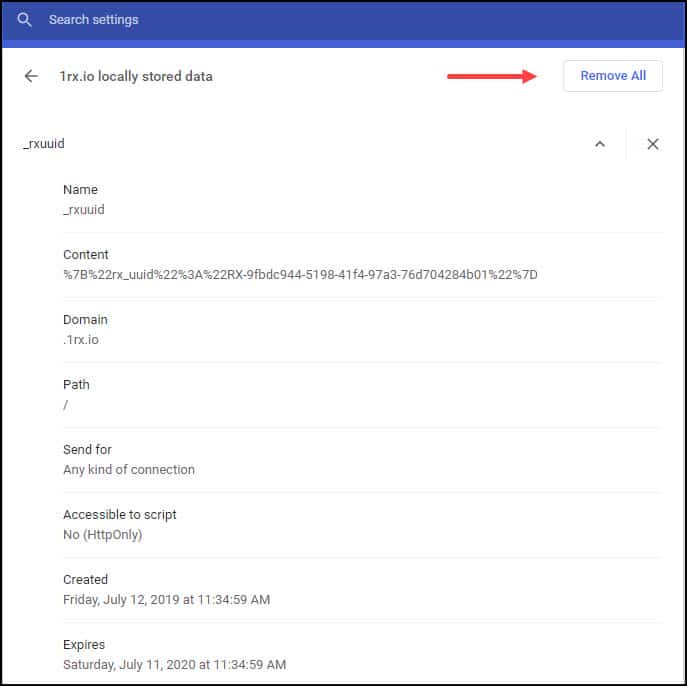
Now, Google Chrome shows the cookie count and permissions.
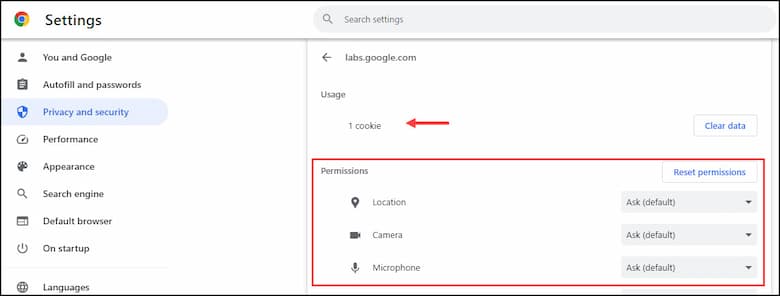
[D] Delete a site’s cookies
Clicking the trash can icon deletes all cookies for that site.
How to Clear All Cookies
Sometimes you need to delete all cookies and not mess with site-specific ones. This is an option many customer support people suggest.
- In your browser, type or copy this command into the address bar.
chrome://settings/content/all- On the Privacy and Security panel, click the Clear all data button to the far right.
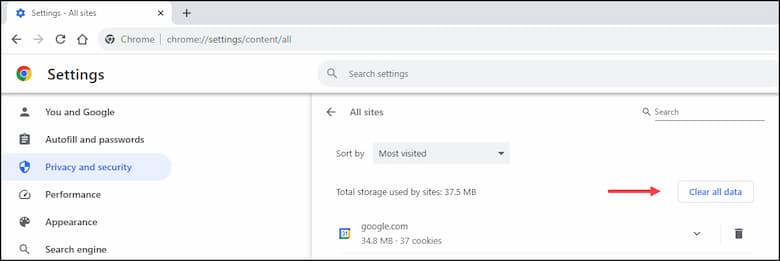
- On the Clear all data pop-up, click the Clear button.

If you’re signed into a Google service, you will need to log in again.
How to Delete all Cookies, Cache, and Browser History
It doesn’t happen all that often, but sometimes you need a clean start. I’ve most often done this when Chrome crashes or doesn’t load resources.
This means clearing cache objects, which may mean the site loads slower until those image resources and files are downloaded again. It will not change your Chrome notification settings or Chrome pop-up settings.
This will also impact your https://myactivity.google.com page. However, data will be retained on your https://myaccount.google.com/purchases page if you’re a Gmail user.
- Open Chrome and type in the address bar:
chrome://settings/clearBrowserData- This brings up the Clear browsing data panel.

- If you’re logged into multiple devices, I would sign out first unless you’re having issues across all your devices. And if you use two-factor authentication, please make sure you have your other verification means handy.
- Click the Clear data button.
You should also realize that if you had any domains showing in the Allow section on your Cookies page, they would be preserved.
How to Clear Cookies for One Site
I’m a creature of habit, and each Wednesday, I view my local supermarket’s website to see the specials. Some deals are unique to me, so I need to log in to see them. Sometimes, I can’t log in. Each time I get a message saying my session has expired and need to log in again. This usually indicates a site cookie got corrupted.
You’ve probably encountered a similar scenario. As expected, tech support wanted me to delete all my cookies and clear the cache. It’s the easiest solution for them. While that will typically solve the problem, it can be overkill.
In my case, if I deleted all browser cookies, I’d have to re-authenticate using 2FA on a bunch of sites. So, I like to start by deleting only the cookies associated with the problem site.
- In Chrome’s address bar or Omnibox, type or copy this command:
chrome://settings/content/all- In the search box, type the domain you wish to view. In my example, I’m searching for Safeway.

- Click the Clear displayed data button.
- On the Clear site and permissions dialog box, click Clear.
Checking for Additional Related Domains
Although the steps above solved my problem, sometimes, a site has more cookies that don’t show under its own domain. In this case, you need to use View site information.
- Go to the site that is giving you problems.
- Click the icon to the left of the URL in the browser address bar.
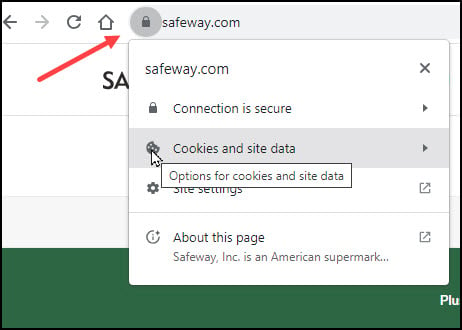
- Click the Cookies and site data heading. You will see another dialog box open with a message at the bottom labeled “Manage cookies and site data.”

- Highlight the additional domain.
- Click the Trash icon.
- Repeat for any other domains you wish to delete cookies.
- Click the Done button.
How to See Cookies in Chrome Developer Tools
If you just cringed when you saw the word “developer,” that’s OK. I’m not one either, but I like this tool for its versatility. Just think of it as a “Swiss Army Website Tool.” Using this tool, you can do everything from inspect cookies to clear cookies.
- Using Chrome, navigate to the website. (e.g., www.timeatlas.com)
- Press the shortcut keys Ctrl + Shift + I.
- Chrome DevTools will open next to your website. In my case, it opens to the side. You can change where the tools dock by clicking the button with three vertical dots.

- Click the >> button at the top and select Application.
- Click the button next to Cookies.
- Right-click the domain name and click Clear.
You may see other sections apart from the main domain. For example, Albertsons owns Safeway so you often see their cookies too.
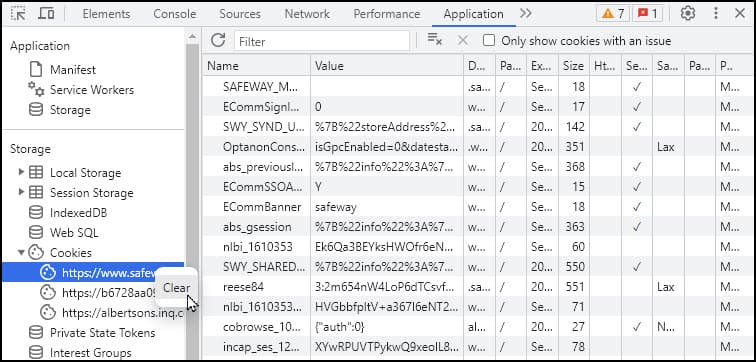
- Click the X button in the top right corner to close Developer tools.
You can also delete individual cookies. Instead of right-clicking the domain, you would select a specific cookie. In the example below, I’ve highlighted the reese84 cookie.
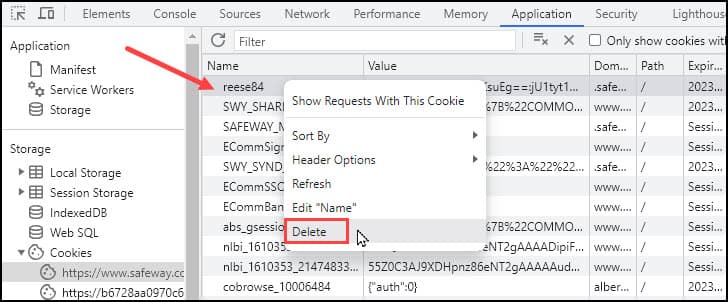
Chrome’s DevTools are pretty powerful and provide other ways to deal with cookies. You can find additional info in their developers’ documentation.
Clear Cookies in Chrome Based on a Time Range
Sometimes you run into a situation where you want to delete cookies based on how long ago they were set. The cookie’s expiration date doesn’t play into this.
- In your browser address bar, type:
chrome://settings/clearBrowserData- The Clear browsing data panel opens.

- Click the Time range field. It will show a drop-down menu with options ranging from Last hour to All Time.
- Select your desired range.
- Deselect Browsing history and Cached images and files.
- Click the Clear data button.
Allowing Selective Cookies
As mentioned earlier, cookies are essential for many sites. It is possible to restrict one without realizing it because we typically don’t know how a website is constructed. Suddenly, you’re trying to take action like chatting with a support rep or making a purchase, and nothing happens. Sometimes we forget our browser settings are the issue. Maybe we’ve blocked 3rd party cookies.
This happened to me last month when I went to start an online chat. I kept clicking the Chat button, and nothing happened.
When I glanced at my browser bar, I could see the cookie icon and the red square. This red square indicates one or more cookies were blocked.
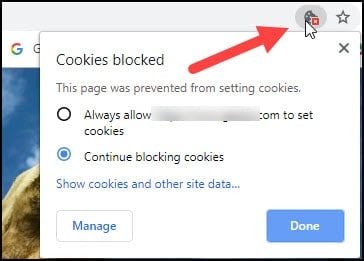
To enable a blocked cookie,
- Click the browser icon. This will open the Cookies blocked overlay.
- Click the blue link Show cookies and other site data…
- At the Cookies in Use panel, click the Blocked heading on the right.
- Scroll through the list of cookies to find the one you want to allow. In my case, it was static.olark.com. I knew oLark was a chat company.
- Click to highlight the entry.

- Click the Allow button. You should see a small info message above the button bar that says, “Cookies from static.olark.com allowed”.
- Click the Done button.
- Reload your web page. It would be best if you did this to get the new cookie.
If you were to go back to chrome://settings/content/cookies, you would see this oLark entry now shows under your Allow section. This also means that the cookie will be allowed on other websites that also use this chat vendor.
Chrome Actions Cookies Shortcuts
Starting with Google Chrome 87, a new feature has been added to the browser. It’s been rolled out gradually. The feature is called Chrome Actions, and it allows you to type your intent in the address bar. All told, there are hundreds of commands, including word variations. For example, there are 130 or so actions related to cookies.
The process is simple. In the example below, you can see I typed “clear cookies” in the browser address bar. Chrome responded by showing a drop-down link to Clear browsing data. While this won’t delete your cookies, it will take you to the correct settings panel.

This feature currently works on Google Chrome. Even though Microsoft Edge and other browsers are built on Chromium, they don’t have this feature.